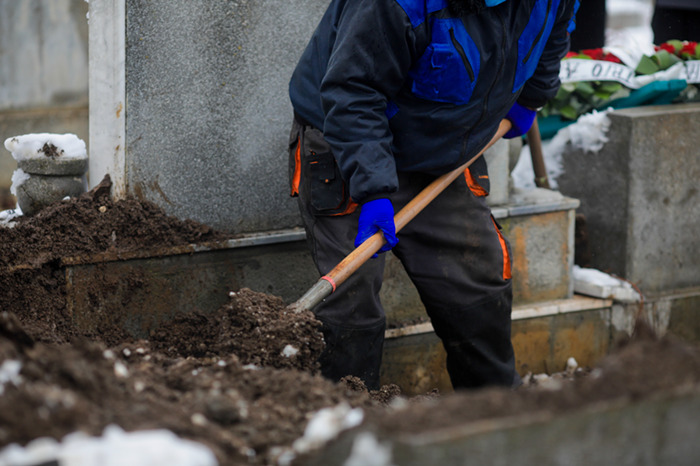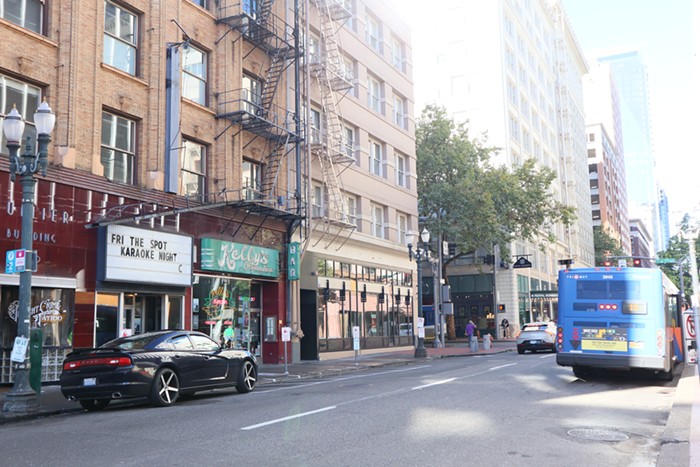RISING ABOVE a grove of oak trees, the sun peeks through the morning mist to shine down on Willamette Valley's Lochmead dairy farm and the serenity of its dew-covered, emerald fields.
The smell, as they say, is something else.
Manure from roughly 1,100 cows is being "flushed" from the animals' homes. The shit sloshes down a long, thin canal—a steadily flowing stream of cocoa-colored slurry—until it arrives in a large concrete pit just past the thick rubber knee-high boots of 72-year-old Jock Gibson, the farm's co-owner. I'm standing next to him, wearing sneakers and regretting my choice of footwear.
Gibson, whose family has farmed here since 1941, seems inured to the smell. I'm not. The odor bullies all other smells from my nostrils, causing a burning sensation behind my eyeballs. It feels like my optic nerve is being repeatedly plucked like a ukulele at a luau. But I'm not here because of the stench wafting off all this crap. I'm here because of what I can't smell. I'm interested in a powerful—and odorless—greenhouse gas called methane.
Methane is second only to carbon dioxide as the leading cause of human-made climate change. And, although it emanates from sources as wide ranging as rice paddies, landfills, and melting arctic permafrost (not nearly as "perma" as we might hope), it's livestock—sheep, cattle, and dairy cows mostly—that make up the planet's single largest human-related source of methane. And, per animal, dairy's methane far outpaces the meat industry's footprint. As a lover of dairy, I find this disturbing. Luckily, there are smart folks on the case.
One of the solutions might be found here on Jock Gibson's farm, in the river of poop flowing into the pit. (More on that later.) Elsewhere, a handful of intrepid researchers are working diligently to unravel a scientific Gordian knot: how to make a climate-friendlier cow. They've discovered our planet's fate might just depend on investigating—no kidding—shit and burps. Our story—which is literally as dark and mysterious as the inside of a cow—begins at her mouth and ends with her backside. Like a Saturday night turned sour, our odyssey starts with some innocent grass and ends with us mired in crap, seemingly at our wits' and world's end.
Burps, Not Farts, and Lots of Grass
Let's get one thing über clear: This is really about burps—not farts.
"We are talking just about the front side, not the backside," says University of California, Davis researcher Frank Mitloehner over the phone.
Regardless of what lazy reporters might lead you to believe, the scientific consensus is this: Cows emit the vast majority of methane through their mouths, not their butts. (Methane from manure is another story, but we'll get there.)
Mitloehner is a leading researcher on these front-side methane emissions. You read that right: He's made a career measuring "burps." In fact he's well known—in circles that know such things—for helping create a methane-measuring technique his colleagues have dubbed, "The Bovine Bubble." It's what it sounds like: a bubble-like tent with cattle or cows in it.
Mitloehner doesn't like this moniker for his "Ventilated Hood System for Measuring Greenhouse Gas and Volatile Organic Compound Emissions from Cattle." Naturally, he doesn't use the word burp. The technical gravitas-adding designation he prefers is "eructations." (Not "eruptions" as the New York Times misquoted him once. Which is perhaps why I get the impression he tires easily of slow-witted journalists.)
"[A cow] just walks and eats, and walks and eats, and walks and eats," says Mitloehner, explaining the animal's lackadaisical culinary habits. "And then everything goes down into the rumen."
Ah yes, the rumen—the largest chamber of the cow's four-part "stomach." The rumen provides the namesake for ruminants—a class of animals that includes sheep, buffalo, cows, and other animals with rumina.
The rumen is, well, roomy. To grasp just how spacious, Mitloehner says imagine a bathtub, which holds about 40 to 50 gallons. A mature dairy cow's rumen holds about the same. She needs all this space, says Mitloehner, to convert those vast heaps of grass into body mass, useable energy, and, eventually, the baby-cow food we've co-opted to create cheese, yogurt, and the creamy canvas on which Salt & Straw paints their frosty masterpieces. And mama cow has friends to help her with all that grass.
It's a Jungle in There
The cow's rumen is warm—again, like an inviting tub. But take note: You wouldn't want to melt into it after a long day at the office. Bessy's rumen contains around 100 billion bacteria per milliliter. And there are other denizens in her dark, dank micro-ecosystem, including fungi, protozoa, and archaea. Together, they help the cow digest her meal. The byproduct is methane.
"Basically, it takes a very complex group of microorganisms to aid digestion," explains Karen Beauchemin, a researcher at Agriculture and Agri-Food Canada—Canada's version of the USDA—and a leading expert on fighting methane emissions from bovines and other ruminants.
(She's also very patient with ruminating reporters.)
Beauchemin says the rumen's swarming life forms all work together in a "kind of consortium." Nonetheless, it's one group of archaea—called methanogens—that are largely responsible for the methane-rich belches. Beauchemin and her science-wielding, burp-fighting ilk are focusing on how to keep these pesky critters from creating methane.
To that end, she's been investigating a compound called 3-Nitrooxypropanol (NOP). (Don't worry. This won't be on the test.) Basically, NOP throws a monkey wrench into the production of methane. Cows who eat it have been shown to burp up to 60 percent less methane—outperforming other potential methane-lowering food, according to Beauchemin's research.
Even so, Beauchemin stresses, actual down-on-the-farm numbers might not reach such lofty heights. She also envisions a day when cows are fed a supplement filled with non-methane-emitting microbes able to duke it out with the methanogens for dominance of the rumen—think yogurt meets Game of Thrones. But, she says, the research examining this microbiological warfare has a way to go.
For now, the best way to keep a cow from belching too much methane is to change her diet. For proof, look no further than the much-derided feedlot. (For the agriculturally disinclined, a feedlot is where livestock are fattened up before we slaughter them.)
"A lot of people point at feedlots and say, 'Look at all that methane coming from feedlots,'" says Mitloehner. "Feedlots produce very little methane.... Grazing animals produce way more."
He's right. Animals in feedlots aren't happily munching grass in a pasture. They're being fed diets high in starchy foods like corn—which, in effect, starves their methanogens. (Legumes, such as soy, will also do the trick.)The diet produces a lot less methane than pasturing. In fact, comparing bovine-to-bovine, dairy's greenhouse gas emissions are higher than meat production's. And organic dairy—which is required to pasture its animals for four months out of the year—leads the bunch in methane emissions.
But a starchy diet is hardly a panacea, and none of the scientists I spoke with are suggesting we lock up our cows to solve our methane woes. Unsurprisingly, neither is organic dairy.
Organics
"We feel that pasturing is the core of a sustainable farming operation," says Jonathan Reinbold, sustainability program manager for the organic milk co-op Organic Valley.
You might have noticed Organic Valley recently had a marketing campaign called "Greenest Pastures." The co-op also launched "Grassmilk"—a milk line from cows who are fed only grass, according to the co-op's website. In conjunction with these campaigns, Organic Valley has been promoting research—some of which it's been funding—that highlights the ecological and health benefits of grass-fed cows.
This might be why Reinbold pointed me to a University of Wisconsin study that sings the praises of pasturing. According to the study, a method called "management-intensive rotational grazing" creates a "carbon sink." Which is another way of saying it helps plants grab climate-changing carbon from the atmosphere and trap it in the soil.
"That's the only management system that's been shown to be a carbon sink," says Reinbold.
Yet, there's a glaring problem with this argument: It skirts the whole "climate-killing burping" issue.
Still, pasturing has one major advantage over the mostly barn-kept method of conventional dairies: Even though they belch more methane, grazing animals' manure produces less methane.
Methanogens don't do so well in the oxygen-rich environment of our planet's atmosphere. So once they get pooped out and exposed to air—along with the other oxygen-phobic microbes from the cow's gut—well... it helps if you envision the end of Nosferatu.
However, if your bovines are in a conventional dairy, where their poop is collected in one place—were you to keep it safe from the clutches of oxygen, say, in a "digester"—then the methane production starts anew. Here, steely-eyed Lochmead dairy farmer Jock Gibson has a solution.
But where the burp side of the shit/burp methane problem needs a technological fix, the shit side needs something more improbable: a political one.
The Ass End: What to Do With All That Shit?
"When it gets up to [a] certain level," Gibson says, pointing at the crap-filling lagoon, "then the pumps go on, and it goes to one of these tanks."
Gibson points to three massive silo-shaped structures behind us. Together, they're capable of holding about one million gallons of manure. What's happening in these tanks, called digesters, is a type of fermentation. Think of the digesters like a home brew attempt gone terribly, horribly, Oh-My-Godforsakenly awry.
Here the microbes feast on feces, not mashed grains. The result is—you guessed it—more methane. However, this methane is sucked into an engine that burns the gas, producing electricity for the Gibsons and the regional power grid. The process significantly lowers the farm's carbon footprint. Of course, the Gibsons aren't the only people to notice the benefits of digesters.
"When they're operated well, digesters really are the best for mitigating the release of methane from manure," says University of Arkansas professor Greg Thoma.
Thoma was the lead scientist on a 2013 industry-funded study that tracked US dairy's carbon footprint. The study concluded the majority of the industry's impact happens before the milk leaves the farm gate—with methane as the biggest culprit. Thoma thinks digesters could cut that footprint significantly. (He calls digesters the "Cadillac" of methane mitigation.) Nonetheless, there's a reason digesters aren't popping up like magic mushrooms on Texas cow pies.
"They're just not always economically viable," says Thoma.
Oregon, for example, has just five dairy digesters, according to the Environmental Protection Agency. But that's partly due to a sagging political will, including the expiration of the Business Energy Tax Credit, which was created to encourage investment in renewables. Digesters also work best on big farms where there's lots of shit. Lastly, the digester business model is, in a word, goofy.
Take the Lochmead dairy farm: The Gibsons don't own the digester, the massive tanks, or the engine—none of it. It's all owned by a Washington, DC, company called Revolution Energy Solutions (RES). RES, in turn, doesn't own the land or poop that fuels its digesters. Ergo, it requires long-term commitments from its dairies, something Gibson says many farmers can't make.
Still, many have high hopes for digesters—they want to do things like throw in food waste to help crap-deficient, smaller farms—but in the meantime, the dairy industry is focusing on another way to cut its emissions: efficiency.
In conjunction with Thoma's study, US dairy via its advertising arm, Dairy Management, Inc., has committed to lowering its carbon footprint by 25 percent by 2020. To that end, it's created the Innovation Center for US Dairy and the "Cow of the Future" program, which focuses on—among other things—funding research on cow burps . (Mitloehner laments he's seen none of this money.) The program is also investigating how to help American dairy farmers squeeze more milk from their herds.
"With sustainability, it has to pay. [Farmers] won't do it if there isn't a return to the bottom line," says 57-year-old California dairy farmer Stephen Maddox.
Maddox helps run the Cow of the Future project. Lately, he's been traveling from farm to farm looking for ways to improve efficiency. I tell him folks like Mitloehner and Beauchemin say that, here in the developed world, our cows are already pretty damn good at making milk. Their solution for fighting methane is to tackle it head on with specific technologies like food additives and digesters.
"Technically they're right," says Maddox. "But at least for several years, there is no other country ready to supply the world market like the United States."
That's the kicker. Assuming our herds stay roughly the same size, more efficient dairies means, sure, less methane per cow, but only because they're making more milk. And for that you need markets that are able to absorb the creamy excess. Maddox says Pacific Rim countries like China can do that. Our talk turns to climate change.
"I don't think humans should be so arrogant to think that we can impact things that much," says Maddox.
I ask for a clarification. And he explains that he doesn't find the mountains of evidence, the current scientific consensus—that humans are potentially catastrophically altering the Earth's climate—compelling. "Seriously," I think to myself, "this is the person that public relations sent me to?" Our conversation ends.
Maddox calls me back five minutes later to explain what he meant. He says he believes in absolutes in math, not science. But he's still hedging his bets and doing his part for the environment. He's put in a solar installation on his dairy, he says.I don't bother asking what processing, refrigerating, and shipping that extra dairy overseas could mean for his industry's environmental footprint. I hang up, leaving Maddox on his drought-ridden farm outside Fresno.
Of course, maybe it doesn't matter. US dairy puts its carbon footprint at only two percent of the national total. Who cares, if according to Beauchemin's numbers, your average cow produces the carbon-dioxide equivalent of driving about 26,000 miles a year? Unfortunately, I care.
Why Your Annoying Vegan Friend Is Probably Fucking Right After All
There's another, no-brainer solution to our methane troubles. It's one I don't want to consider. I already don't eat much meat, but my diet is mostly lacto vegetarian. And I fucking love dairy. So I wasn't keen on what Oregon State University professor William Ripple had to tell me.
"Most of the focus today has been on fossil fuel reduction," says Ripple, "but lowering carbon emissions will not be enough to abate serious climate change."
Ripple's recent paper, published in Nature Climate Change, suggests that to lower our carbon footprint, we need to tackle methane from livestock.
According to his numbers, the world's 3.6 billion domesticated ruminants account for about 14.5 percent of human-made greenhouse gases worldwide, and methane is about 21 times greater an atmospheric heat-trapper than carbon dioxide. But—and here's the silver lining—unlike carbon dioxide, which can hang out for decades and decades, methane departs after less than 10 years. This means going after methane's sources could produce a quick turnaround—the kind climate scientists warn is necessary if our planet is to avoid runaway climate change and ecocide. Ripple for one is walking the talk: He's gone vegan.
Okay, you're thinking: Vegan food kind of sucks. It's true. And we could also reduce methane by switching our menus from ruminants to "monogastric" animals, like pigs, poultry, and people. Okay, maybe not people. Even so, vegetable protein consistently has a lower carbon footprint than animal protein—maybe not enough to keep our world from resembling a Paolo Bacigalupi novel, but, Ripple says, it could help.
Leaving
My visit to the Lochmead farm is ending. I wipe the shit off my shoes and climb into Gibson's Ford Expedition, (license plate: "MR MOO"). I ask him about his industry's lofty emissions-lowering goal. He answers frankly.
"I have no idea how the dairy industry is going to lower their carbon footprint by 25 percent," he says.
I consider cooking vegan that night.
A shorter, less detailed version of this story originally ran in Edible Portland.













